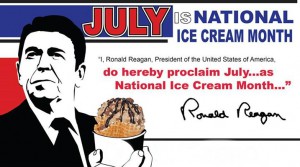July: National Ice Cream Month
Why not start this month off with a treat! In 1984, President Ronald Reagan declared July as National Ice Cream Month and the third Sunday in July (July 19th) as National Ice Cream Day! Actually, the whole month of July is supposed to be celebrated with “appropriate ceremonies and activities.” Ice cream is both nutritious and delicious…… eaten in moderation of course, but it can also be confusing. Not all frozen treats are in fact ice cream!
What really is ice cream? Real ice cream or ice-cream is a frozen dessert made from dairy products, such as milk and cream, combined with flavorings and sweeteners, such as sugar. American federal labeling standards require ice cream to contain a minimum of 10% milk fat per 1/2 cup serving and 20% total milk solids by weight. This mixture is stirred slowly while chilling to prevent large ice crystals from forming. A term used in making commercial ice cream is overrun. Overrun means the liquid mixture, once completely chilled can have expanded up to double its original volume by the incorporation of air. This results in a smoothly textured ice cream free from palpable ice crystals or sandiness.
Overrun helps explain the vast price discrepancy between ice cream brands. More expensive brands normally use more and better quality ingredients and have less overrun whereas as less expensive ice cream brands tend to use the minimum amounts of ingredients required by law and more air. Thus, the weight of a half-gallon can indicate quality too.
There are many variations to the basic ice cream recipe. Reading the label of a favorite product helps the consumer learn what is in their favorite brand.
When egg yolk solids are added to ice cream the name has to reflect this. “Frozen custard” or “French ice cream” or “French custard ice cream” is ice cream with the added egg yolk.
Super premium ice cream tends to have higher than standard ice cream recipe. High fat contents and more expensive, best quality ingredients add calories and expense.
Ice milk is not a type of ice cream you see much anymore: it has been replaced by reduced fat products. Years ago ice milk was the low fat version of ice cream. Ice milk is not required to contain the standard minimum of milk fat. However, reduced fat ice cream is required by law to have 25% less fat than that particular company’s regular version. Nonetheless, calories lost here by reducing the milk fat might be made up by other added ingredients such as candy bits. Even light versions of the premium brands can have more fat and calories than plain ice cream. Again, you learn a lot from a label.
Frozen yogurts, made from yogurt, are a dairy product, with the addition various sugars and flavorings. However, yogurt’s reputation for healthfulness is not always accurate and unlike ice cream there are no Federal standards of any kind for frozen yogurt
Gelato is a type of soft ice cream containing a relatively small amount of air. This makes the product dense, rich and creamy. Gelato can be made with milk, cream, various sugars, and flavoring such as fresh fruit. Gelato is generally lower in calories, fat and sugar than ice cream. In the United States there is no standard of definition for gelato set forth by the United States Food and Drug Administration.
Are sorbet, sherbet, and sherbert all the same? Despite the fact that the legal definitions of sorbet and sherbet could be used interchangeably, there is a distinction among American frozen dessert manufacturers. Sherbet — which is alternatively spelled sherbert — is a frozen fruit and dairy product that contains anywhere from 1 percent to 3 percent milk fat from milk or cream. On the other hand, sorbet generally implies a fruit-based frozen dessert with little to no dairy — although the use of the term sorbet is unregulated industry standards want them free from surface crustation, brittleness, syrup bleeding, and large ice crystals.
Confused yet? New to the frozen dessert market are novelty frozen concoctions made with nondairy to mimic ice cream. Welcome, delicious dairy free, soy milk, coconut milk and almond milk frozen desserts. Notice, these products are not called ice-cream but are so smooth and creamy you might not even realize.
In 1984, when President Ronald Regan’s crafted the unique proclamation to eat ice cream folks didn’t have so much to choose from. You do. Enjoy a frozen treat but know what you are buying…….. You can learn a lot from a label.
http://www.icecream.com/icecreaminfo
[Code of Federal Regulations] [Title 21, Volume 2] [Revised as of April 1, 2014] [CITE: 21CFR135.110]
- It’s Chestnut Season! - December 16, 2022
- Persimmons: Food of the Gods - November 23, 2022
- Have You Ever Thought About Entering Baked Goods in the North Florida Fair? - October 28, 2022

